 |
C++: Examples of Expressions, Use of Operators |
| << C language: Variables, Data Types, Arithmetic Operators, Precedence of Operators |
| Flow Charting, if/else structure, Logical Operators >> |
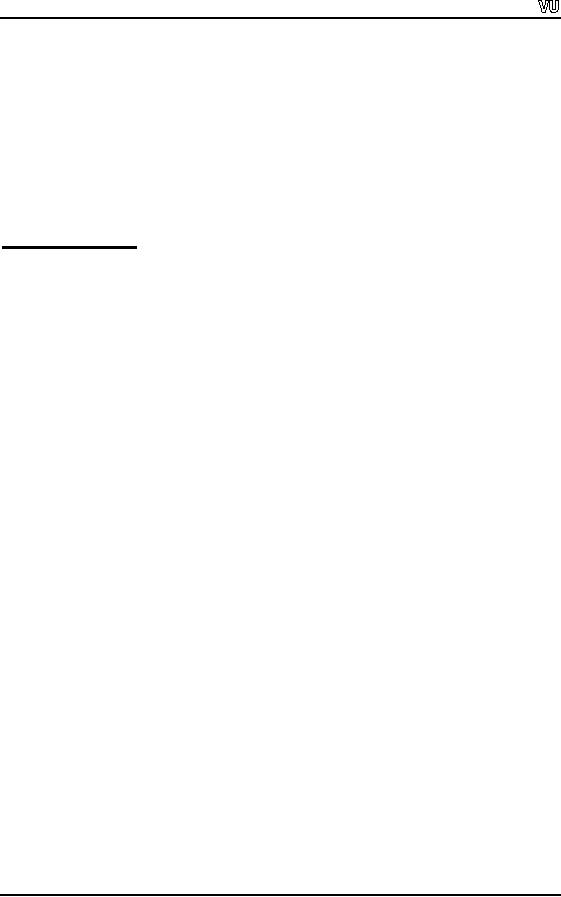
CS201
Introduction to Programming
Lecture
Handout
Introduction
to programming
Lecture
No. 4
Reading
Material
Deitel
& Deitel C++ How to
Program
chapter
1
1.22
Summary
Sample
Program
o
Examples
of Expressions
o
Use of
Operators
o
Tips
o
Sample
Program
Problem
statement:
Calculate
the average age of a class
of ten students. Prompt the
user to enter the age
of
each
student.
Solution:
Lets
first sort out the problem.
In the problem we will take
the ages of ten students
from
the
user. To store these ages we
will use ten variables,
one variable for each
student's
age. We
will take the ages of
students in whole numbers
(in years only, like
10, 12, 15
etc), so
we will use the variables of
data type int. The
variables declaration statement
in
our
program will be as follow:
int
age1, age2, age3, age4,
age5, age6, age7, age8,
age9, age10;
We have
declared all the ten
variables in a single line by using
comma separator ( , ).
This is a
short method to declare a
number of variables of the
same data type.
After
this we will add all
the ages to get the total
age and store this
total age in a variable.
Then we
will get the average
age of the ten students by
dividing this total age by
10. For
Page
23
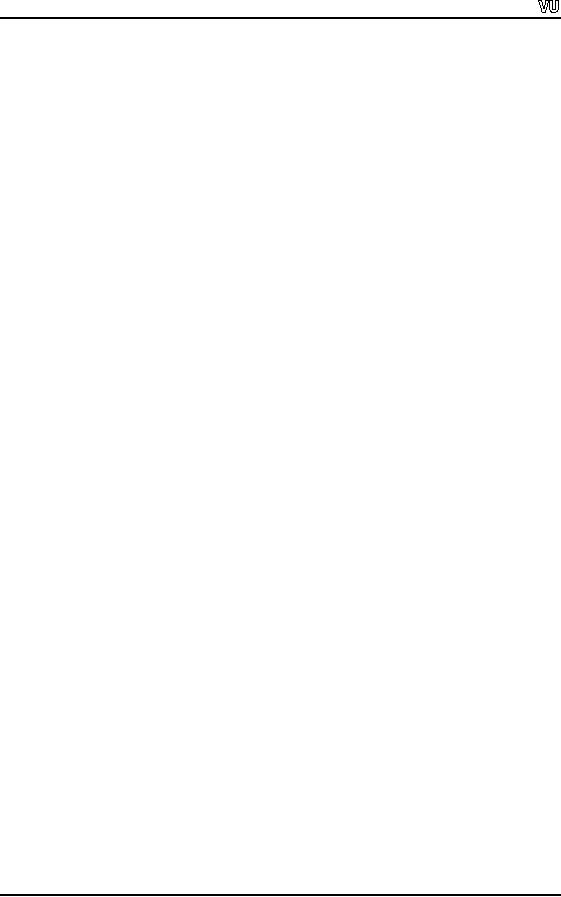
CS201
Introduction to Programming
the
storage of total and average
ages we need variables. For
this purpose we use
variable
TotalAge
for
the total of ages and
AverageAge
for
average of ages respectively.
int
TotalAge, AverageAge;
We have
declared AverageAge
as
int data type so it can
store only whole numbers.
The
average
age of the class can be in
real numbers with decimal
point (for example if
total
age is
173 then average age
will be 17.3). But the
division of integers will
produce
integer
result only and the
decimal portion is truncated. If we
need the actual result
then
we should
use real numbers (float or
double) in our
program.
Now we
have declared variables for
storing different values. In the
next step we prompt
the
user to enter the age of
first student. We simply
show a text line on the
screen by
using
the statement:
cout
<< "Please enter the
age of first student : "
;
So on the
screen the sentence "Please
enter the age of first
student:" will appear.
Whenever
we are requesting user to
enter some information we
need to be very clear
i.e.
write
such sentences that are self
explanatory and user understands them
thoroughly and
correctly.
Now with the above
sentence everyone can
understand that age would
be
entered
for the first student. As we
are expecting only whole
numbers i.e. age in
years
only i.e.
10, 12 etc, our program is
not to expect ages as 13.5
or 12.3 or 12 years and
3
months
etc. We can refine our
sentence such, that the
user understands precisely that
the
age
would be entered in whole
number only.
After
this we allow the user to
enter the age. To, get
the age
entered
by the user into a
variable, we use
the statement:
cin
>> age1;
Lets
have a look on the statement
cin
>> age1; cin
is
the counter part of the
cout.
Here
cin
is
the input stream that
gets data from the
user and assigns it to the
variable on its
right
side. We know that the sign
>> indicates the direction of
the flow of data. In
our
statement
it means that data comes
from user and is assigned to
the variable age1,
where
age1
is a
variable used for storing the
age entered for student1.
Similarly we get the
ages
of all
the ten students and
store them into respective
variables. That means the
age of first
student
in age1, the
age of second student in age2
and so on
up to 10 students. When cin
statement
is reached in a program, the program
stops execution and expects
some input
from
the user. So when cin
>> age1; is
executed, the program
expects from the user
to
type the
age of the student1. After
entering the age, the
user has to press the
'enter key'.
Pressing
'enter key' conveys to the
program that user has
finished entering the input
and
cin
assigns
the input value to the
variable on the right hand
side which is age1
in
this
case. As
we have seen earlier that in
an assignment statement, we can
have only one
variable on
left hand side of the
assignment operator and on
right hand side we can
have
an
expression that evaluates to a single
value. If we have an expression on
the left hand
Page
24
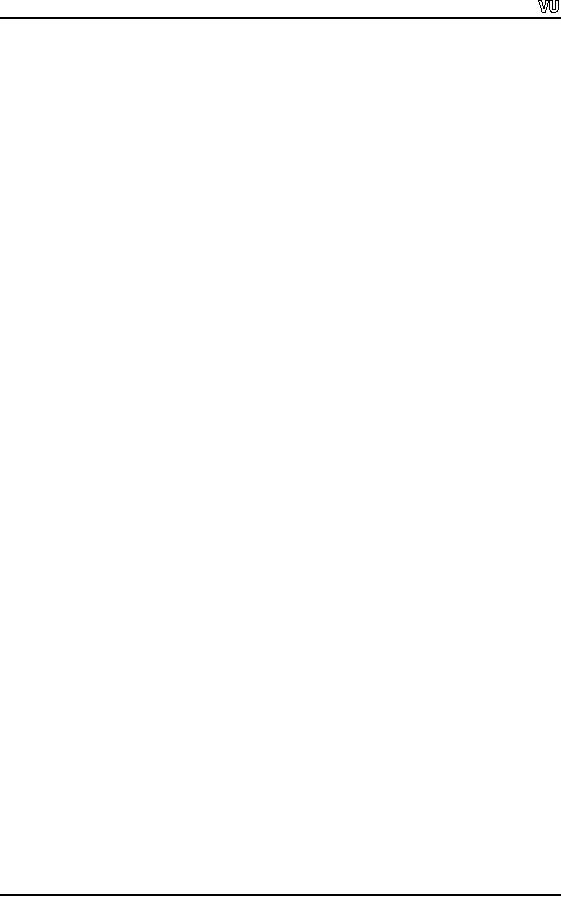
CS201
Introduction to Programming
side of
assignment operator we get an
error i.e. x = 2 + 4;
is a
correct statement but x +
y
= 3+ 5;
is an
incorrect statement as we can not
have an expression on the
left hand side.
Similarly
we can not have an
expression after the >> sign
with cin. So we
can have one
and
only one variable after >> sign
i.e. cin
>> x; is a
correct statement and cin
>> x + y;
is an incorrect
statement.
Next, we
add all these values
and store the result to
the variable TotalAge. We
use
assignment
operator for this purpose.
On the right hand side of
the assignment
operator,
we write
the expression to add the
ages and store the
result in the variable, TotalAge
on
left
hand side. For this
purpose we write the
statement as follow:
TotalAge =
age1 + age2 + age3 + age4 +
age5 + age6 + age7 + age8
+
age9
+ age10 ;
The
expression on the right hand
side uses many addition
operators ( + ). As these
operators
have the same precedence,
the expression is evaluated
from left to right.
Thus
first
age1
is
added to age2
and
then the result of this is
added to age3
and
then this result
is added
to age4
and so
on.
Now we
divide this TotalAge
by 10
and get the average
age. We store this average
age in
the
variable i.e. AverageAge
by
writing the
statement:
AverageAge
= TotalAge / 10;
And at
the end we display this
average age on the screen by
using the following
statement:
cout
<< " The average age of
the students is : " <<
AverageAge;
Here the
string enclosed in the quotation marks,
will be printed on the screen as it is
and
the
value of AverageAge
will be
printed on the screen.
The
complete coding of the program is given
below:
/* This
program calculates the
average age of a class of
ten students after prompting
the
user to
enter the age of each
student. */
#include
<iostream.h>
main
()
{
//
declaration of variables, the
age will be in whole
numbers
int
age1, age2, age3, age4,
age5, age6, age7, age8,
age9, age10;
int
TotalAge, AverageAge;
// take
ages of the students from
the user
cout
<< "Please enter the
age of student 1: ";
cin
>> age1;
Page
25
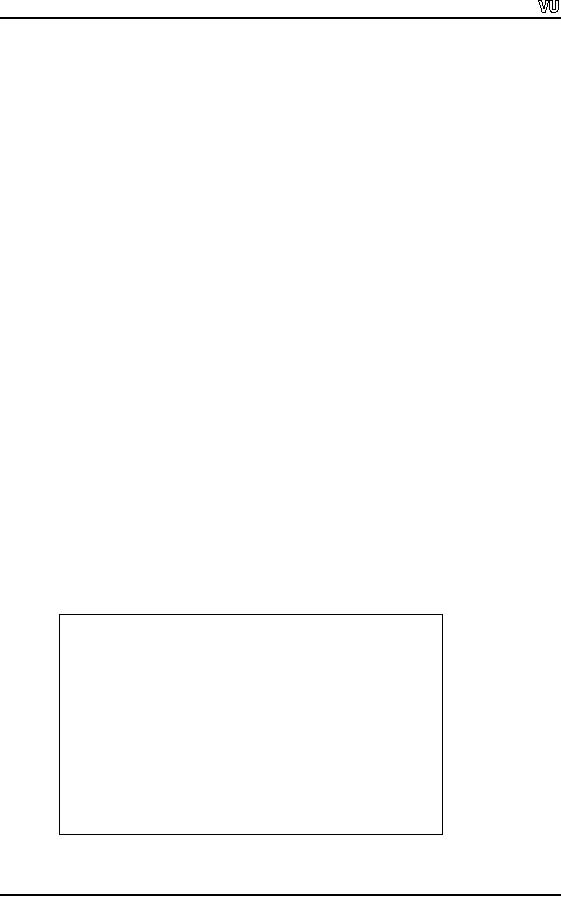
CS201
Introduction to Programming
cout
<< "Please enter the
age of student 2: ";
cin
>> age2;
cout
<< "Please enter the
age of student 3: ";
cin
>> age3;
cout
<< "Please enter the
age of student 4: ";
cin
>> age4;
cout
<< "Please enter the
age of student 5: ";
cin
>> age5;
cout
<< "Please enter the
age of student 6: ";
cin
>> age6;
cout
<< "Please enter the
age of student 7: ";
cin
>> age7;
cout
<< "Please enter the
age of student 8: ";
cin
>> age8;
cout
<< "Please enter the
age of student 9: ";
cin
>> age9;
cout
<< "Please enter the
age of student 10: ";
cin
>> age10;
//
calculate the total age
and average age
TotalAge
= age1 + age2 + age3 + age4
+ age5 + age6 + age7 + age8
+ age9 +
age10;
AverageAge =
TotalAge / 10;
//
Display the result ( average
age )
cout
<< "Average age of class
is: " << AverageAge;
}
A sample
output of the above program is given
below.
Please
enter the age of student 1:
12
Please
enter the age of student 2:
13
Please
enter the age of student 3:
11
Please
enter the age of student 4:
14
Please
enter the age of student 5:
13
Please
enter the age of student 6:
15
Please
enter the age of student 7:
12
Please
enter the age of student 8:
13
Please
enter the age of student 9:
14
Please
enter the age of student
10: 11
Average
age of class is: 12
Page
26
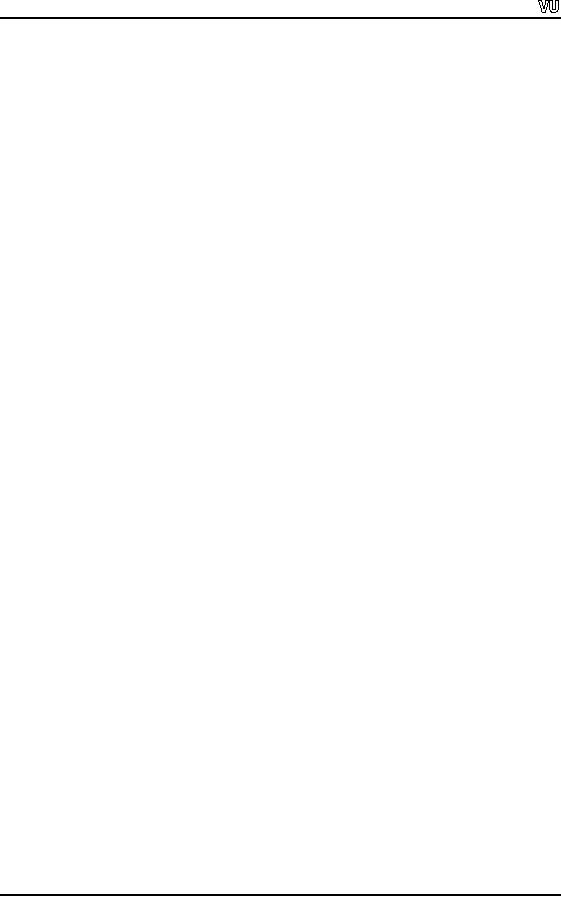
CS201
Introduction to Programming
In the
above output the total age
of the students is 123 and
the actual average should
be
12.3
but as we are using integer
data types so the decimal
part is truncated and the
whole
number 12
is assigned to the variable
AverageAge.
Examples
of Expressions
We have
already seen the precedence
of arithmetic operators. We have
expressions for
different
calculations in algebraic form, and in
our programs we write them in
the form of
C
statements. Let's discuss
some more examples to get a better
understanding.
We know
about the quadratic equation
in algebra, that is y =
ax2 + bx + c. The
quadratic
equation
in C will be written as y = a * x * x +
b * x + c. In C, it is
not an equation but
an
assignment
statement. We can use
parentheses in this statement,
this will make
the
expression
statement easy to read and
understand. Thus we can
rewrite it as y = a * (x
*
x) + (b * y) +
c.
Note
that we have no power
operator in C, just use * to multiply
the same value.
Here is
another expression in algebra:
x = ax + by +
cz2. In C
the above expression
will
be
as:
x=a*x+b*y+c*z*z
The *
operator will be evaluated
before the + operator. We
can rewrite the
above
statement
with the use of parentheses.
The same expressions can be
written as:
x = (a * x) +
(b * y) + c * ( z * z)
Lets
have an other expression in
algebra as x =
a(x + b(y + cz2)). The
parentheses in this
equation
force the order of evaluation. This
expression will be written in C
as:
x = a * (x + b
* (y + c * z * z))
While
writing expressions in C we should
keep in mind the precedence
of the operators
and
the order of evaluation of the
expressions (expressions are
evaluated from left
to
right).
Parentheses are used in complicated
expressions. In algebra, there
may be curly
brackets
{ } and square brackets [ ] in an
expression but in C we have
only parentheses
( ).
Using parentheses, we can
make a complex expression
easy to read and
understand
and
can force the order of evaluation. We
have to be very careful while
using
parentheses,
as parentheses at wrong place
can cause an incorrect result.
For example, a
statement
x = 2 + 4 * 3
results
x =
14.
As * operator is of higher precedence,
4 * 3
is
evaluated
first and then result 12 is
added to 4 which gives the
result 14. We can
rewrite
this
statement, with the use of
parentheses to show it clearly,
that multiplication is
Page
27
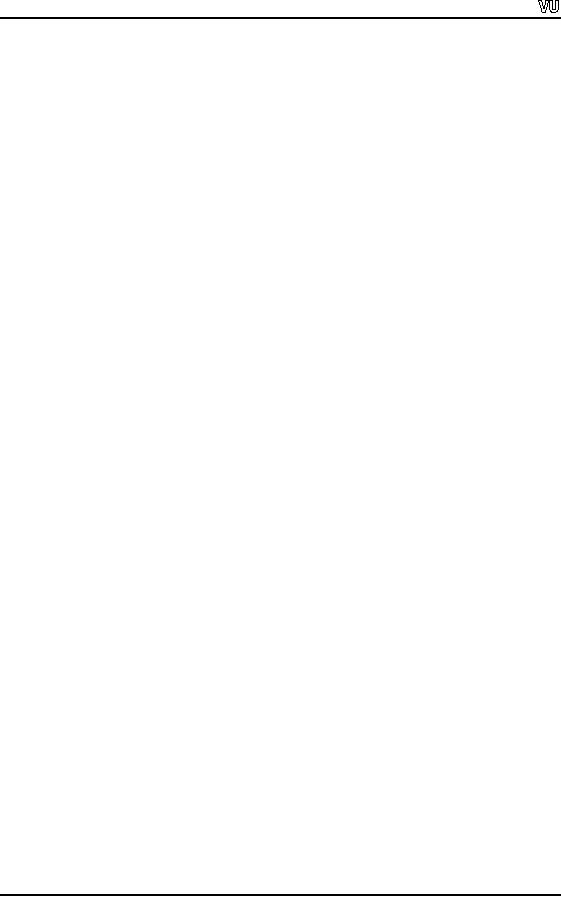
CS201
Introduction to Programming
performed
first. Thus we can write it
as x = 2 + (4 *
3).
But the same statement
with
different
parentheses like x = (2 + 4) * 3
will
give the result 18, so we
have to be careful
while
using parenthesis and the
evaluation order of the
expression.
Similarly
the equation (b2 4ac)/2a can be
written as ( b * b 4
* a * c) / ( 2 * a ).
The
same
statement without using
parentheses will be as b * b 4 *
a * c / 2 * a. This
is
wrong as
it evaluates to b2 4ac/2a (i.e. 4ac
is divided by 2a instead of (b2-4ac)).
Use of
Operators
Here are
sample programs which will
further explain the use of
operators in
programming.
Problem
Statement:
Write a
program that takes a four
digits integer from user
and shows the digits on
the
screen
separately i.e. if user enters
7531, it displays 7,5,3,1
separately.
Solution:
Let's
first analyze the problem
and find out the
way how to program
it.
Analysis:
First of
all, we will sort the
problem and find out how we
can find digits of an
integer.
We know
that when we divide a number
by 10, we get the last
digit of the number
as
remainder.
For example when we divide
2415 by 10 we get 5 as remainder.
Similarly
3476
divided by 10 gives the
remainder 6. We will use this
logic in our problem to
get
the
digits of the number. First of
all, we declare two
variables for storing number
and the
digit.
Let's say that we have a
number 1234 to show its
digits separately. In our
program
we will
use modulus operator ( % ) to get
the remainder. So we get the
first digit of the
number
1234 by taking its modulus
with 10 (i.e. 1234 % 10).
This will give us the
digit 4.
We will
show this digit on the
screen by using cout
statement.
After this we have to
find
the
next digit. For this we will
divide the number by 10 to
remove its last digit. Here
for
example
the answer of 1234 divided
by 10 is 123.4, we need only
three digits and not
the
decimal
part. In C we know that the
integer division truncates
the decimal part to give
the
result in
whole number only. We will
use integer division in our
program and declare
our
variable
for storing the number as int
data
type. We will divide the
number 1234 by 10
(i.e.
1234 / 10). Thus we will
get the number with
remaining three digits i.e. 123. Here
is
a point
to be noted that how can we
deal with this new
number (123)?
Page
28
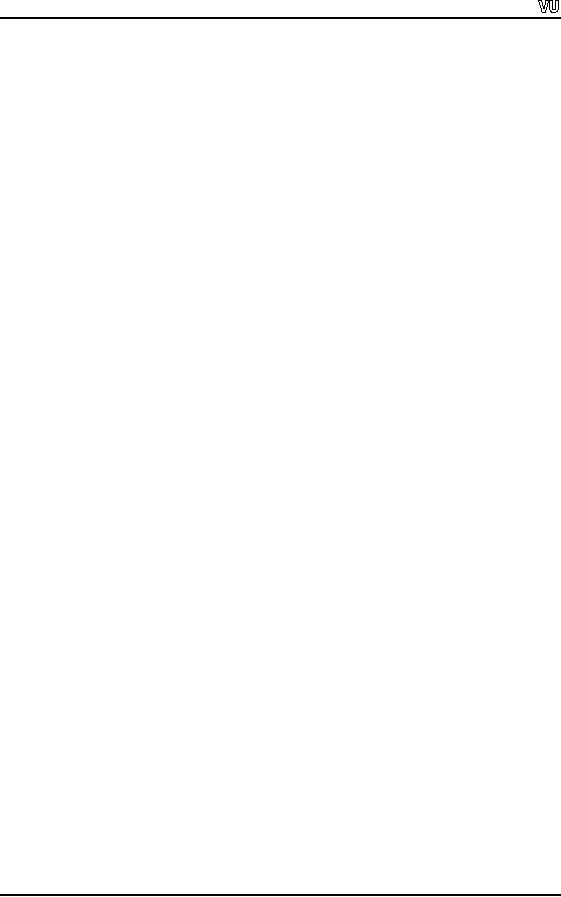
CS201
Introduction to Programming
There
are two ways, one
is
that we declare a new variable of
type int
and
assign the value
of this
new number to it. In this
way we have to declare more
variables that mean
more
memory
will be used. The second
way is to
reuse the same variable (where
number was
already
stored). As we have seen earlier
that we can reassign values
to variables like in
the
statement x = x +
1,
which means, add 1 to the
value of x and assign this
resultant
value
again to x. In this way we
are reusing the variable x. We
will do the same but
use
the
division operator instead of
addition operator according to
our need. For this
purpose
we will
write number
= number / 10. After
this statement we have value
123 in the
variable
number.
Again we
will get the remainder of
this number with the
use of modulus operator,
dividing
the number by 10 (i.e. 123 %
10). Now we will get 3
and display it on the
screen.
To get the new number
with two digits, divide
the number by 10. Once
again, we
get
the next digit of the
number (i.e. 12) by using
the modulus operator with
10, get the
digit 2
and display it on the screen.
Again get the new
number by dividing it by 10
(i.e. 1). We
can show it directly, as it is
the last digit, or take
remainder by using modulus
operator
with 10. In this way, we
get all the digits of
the number.
Now
let's write the program in C by
following the analysis we
have made. The
complete
C program
for the above problem is
given below. It is easy to
understand as we are
already
familiar with the statements
used in it.
/* A program
that takes a four digits
integer from user and shows
the digits on the
screen
separately
i.e. if user enters 7531, it displays
7,5,3,1 separately. */
#include
<iostream.h>
main()
{
//
declare variables
int
number, digit;
// prompt
the user for
input
cout
<< "Please enter 4-digit
number:";
cin
>> number;
// get
the first digit and
display it on screen
digit =
number % 10;
cout
<< "The digits are:
";
cout
<< digit << ", ";
// get
the remaining three digits
number
number =
number / 10;
// get
the next digit and display
it
digit =
number % 10;
Page
29
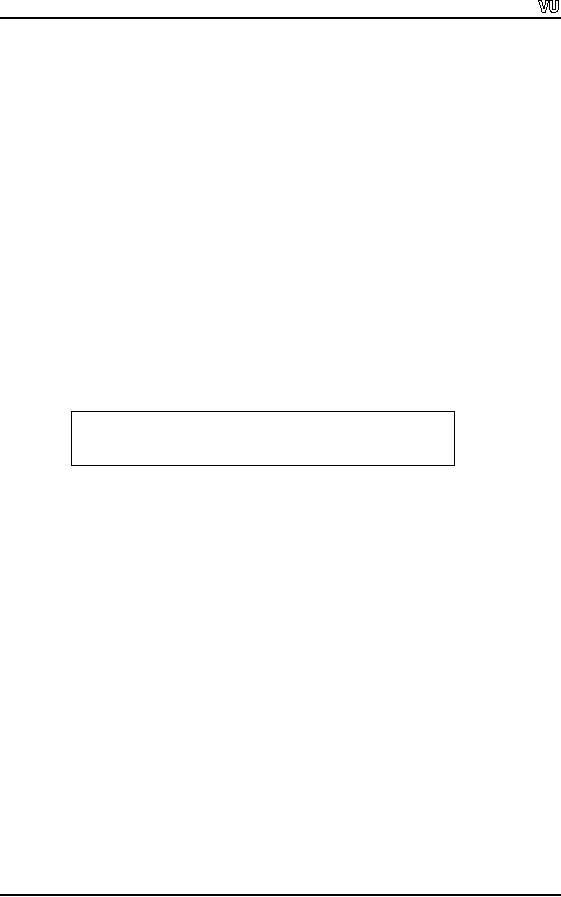
CS201
Introduction to Programming
cout
<< digit << ", ";
// get
the remaining two digits
number
number =
number / 10;
// get
the next digit and display
it
digit =
number % 10;
cout
<< digit << ", ";
// get
the remaining one digit
number
number =
number / 10;
// get
the next digit and
display it
digit =
number % 10;
cout
<< digit;
}
A sample
output of the above program is given
below.
Please
enter 4-digit number:
5678
The
digits are: 8, 7, 6, 5
Problem
Statement:
Write a
program that takes radius of a
circle from the user
and calculates the
diameter,
circumference
and area of the circle
and display the
result.
Solution:
In this
problem we take the input
(radius of a circle) from
the user. For that we
can use
cin
statement
to prompt the user to enter
the radius of a circle. We
store this radius in
a
variable. We
also need other variables to
store diameter, circumference and
area of the
circle.
To obtain the correct result, we
declare these variables of type
float, instead
of int
data
type, as we know that the
int
data type
stores the whole numbers
only. Here in our
problem
the area or circumference of the
circle can be in decimal
values. After getting
the
radius we
use the formulae to find
the diameter, circumference and
area of the circle
and
then
display these results on the
screen. The solution of this
program in coding form is
given
below.
Page
30
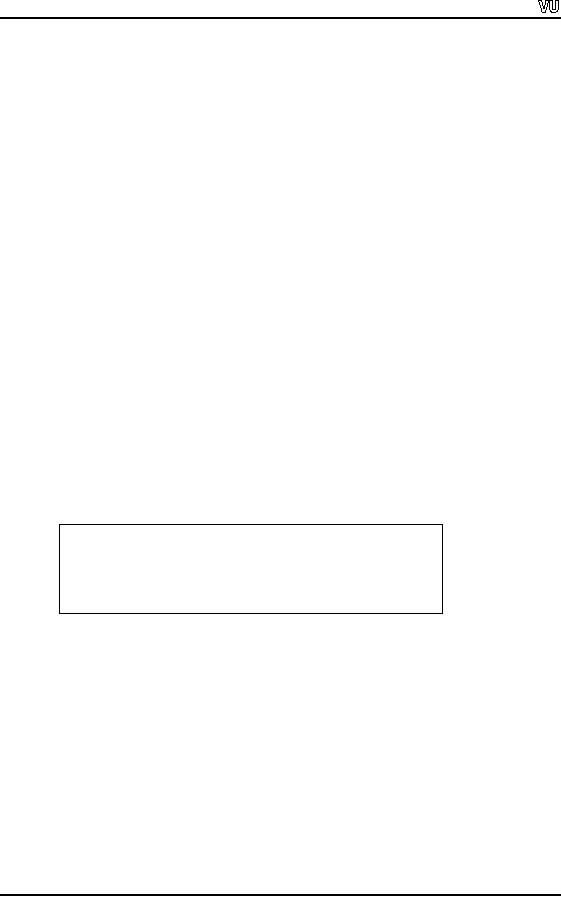
CS201
Introduction to Programming
/*
Following program takes the
radius of a circle from the
user and calculates
the
diameter,
circumference and area of the
circle and displays the
result. */
#include
<iostream.h>
main
()
{
//
declare variables
float
radius, diameter, circumference,
area;
// prompt
the user for radius of a
circle
cout
<< "Please enter the
radius of the circle "
;
cin
>> radius ;
//
calculate the diameter, circumference
and area of the
circle
//
implementing formula i.e. diameter = 2 r
circumference = 2 ח r and
area = ח r2
diameter
= radius * 2 ;
circumference = 2 *
3.14 * radius ; // 3.14 is
the value of ח (Pi)
area =
3.14 * radius * radius
;
// display
the results
cout
<< "The diameter of the circle is :
" << diameter ;
cout
<< "The circumference of the circle is : "
<< circumference ;
cout
<< "The area of the
circle is : " << area ;
}
A sample
output of the above program is given
below.
Please
enter the radius of the
circle 5
The
diameter of the circle is :
10
The
circumference of the circle is :
31.4
The
area of the circle is :
78.5
Tips
Use descriptive
names for variables
o
Indent
the code for better
readability and
understanding
o
Use
parenthesis for clarity and
to force the order of evaluation in an
expression
o
Reuse
the variables for better
usage of memory
o
Take
care of division by
zero
o
Analyze
the problem properly, and then
start coding (i.e. first think
and then write)
o
Page
31
Table of Contents:
- What is programming
- System Software, Application Software, C language
- C language: Variables, Data Types, Arithmetic Operators, Precedence of Operators
- C++: Examples of Expressions, Use of Operators
- Flow Charting, if/else structure, Logical Operators
- Repetition Structure (Loop), Overflow Condition, Infinite Loop, Properties of While loop, Flow Chart
- Do-While Statement, for Statement, Increment/decrement Operators
- Switch Statement, Break Statement, Continue Statement, Rules for structured Programming/Flow Charting
- Functions in C: Structure of a Function, Declaration and Definition of a Function
- Header Files, Scope of Identifiers, Functions, Call by Value, Call by Reference
- Arrays: Initialization of Arrays, Copying Arrays, Linear Search
- Character Arrays: Arrays Comparisonm, Sorting Arrays Searching arrays, Functions arrays, Multidimensional Arrays
- Array Manipulation, Real World Problem and Design Recipe
- Pointers: Declaration of Pointers, Bubble Sort Example, Pointers and Call By Reference
- Introduction, Relationship between Pointers and Arrays, Pointer Expressions and Arithmetic, Pointers Comparison, Pointer, String and Arrays
- Multi-dimensional Arrays, Pointers to Pointers, Command-line Arguments
- String Handling, String Manipulation Functions, Character Handling Functions, String Conversion Functions
- Files: Text File Handling, Output File Handling
- Sequential Access Files, Random Access Files, Setting the Position in a File, seekg() and tellg() Functions
- Structures, Declaration of a Structure, Initializing Structures, Functions and structures, Arrays of structures, sizeof operator
- Bit Manipulation Operators, AND Operator, OR Operator, Exclusive OR Operator, NOT Operator Bit Flags Masking Unsigned Integers
- Bitwise Manipulation and Assignment Operator, Programming Constructs
- Pre-processor, include directive, define directive, Other Preprocessor Directives, Macros
- Dynamic Memory Allocation, calloc, malloc, realloc Function, Dangling Pointers
- History of C/C++, Structured Programming, Default Function Arguments
- Classes and Objects, Structure of a class, Constructor
- Classes And Objects, Types of Constructors, Utility Functions, Destructors
- Memory Allocation in C++, Operator and Classes, Structures, Function in C++,
- Declaration of Friend Functions, Friend Classes
- Difference Between References and Pointers, Dangling References
- Operator Overloading, Non-member Operator Functions
- Overloading Minus Operator, Operators with Date Class, Unary Operators
- Assignment Operator, Self Assignmentm, Pointer, Conversions
- Dynamic Arrays of Objects, Overloading new and delete Operators
- Source and Destination of streams, Formatted Input and Output, Buffered Input/Output
- Stream Manipulations, Manipulators, Non Parameterized Manipulators, Formatting Manipulation
- Overloading Insertion and Extraction Operators
- User Defined Manipulator, Static keyword, Static Objects
- Pointers, References, Call by Value, Call by Reference, Dynamic Memory Allocation
- Advantages of Objects as Class Members, Structures as Class Members
- Overloading Template Functions, Template Functions and Objects
- Class Templates and Nontype Parameters, Templates and Static Members
- Matrices, Design Recipe, Problem Analysis, Design Issues and Class Interface
- Matrix Constructor, Matrix Class, Utility Functions of Matrix, Input, Transpose Function
- Operator Functions: Assignment, Addition, Plus-equal, Overloaded Plus, Minus, Multiplication, Insertion and Extraction